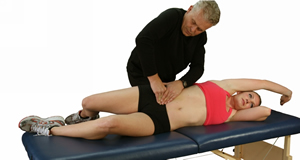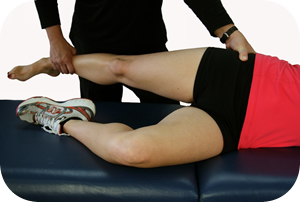Improving Core Stability
 Improving Core Stability with Active Release Techniques
Improving Core Stability with Active Release Techniques
Whether you swim, run, or cycle, it is essential to have core stability to maximize performance and prevent injury.
The core of your body is where you derive your power; it provides the foundation for all arm and leg movements. Your core must be strong, flexible, and unimpeded in its movements to achieve maximum performance.
Motion is not an isolated event that occurs in one direction. Body movement is a complex event involving agonist and antagonist structures that work together to create motion and to stabilize the body in all three directional planes.
What Makes Up the Core
The foundation of your core is much more than just your abdominal muscles. It includes muscles that lie deep within your torso, right up to your neck, and your shoulders. The core includes the following structures SHOULD WE INCLUDE GLUTEAL MUSCLES IN THIS ???:
- Multifidi – Very deep muscles that run from the neck (C3) to the lumbar spine (L5). Approximately two thirds of the static support in your back is produced through contraction of the Multifidus muscles.
- Interspinales, Intertransversarii, Rotatores – Deep structures that attach directly to the spinal column. These are very important for rotatory motion and lateral stability.
- Internal/External Obliques & Transversus Abdominis –These structures transmit a compressive force, and act to increase intra-abdominal pressure that stabilizes the lumbar spine.
- Erector Spinae – These muscles help to balance all the forces involved in spinal flexion.
- Quadratus Lumborum – This muscle stabilizes the 12th rib during respiration and laterally flexes the trunk.
- Thoracolumbar Fascia – This area supplies tensile support to the lumbar spine, and is used for load transfer throughout the lumbar region.
These muscles connect to the spine, pelvis, and shoulders to create a solid foundation of support. When these core muscles are strong, flexible, and move freely, then the athlete is able to generate controlled, powerful movements in his/her arms and legs.
Imbalances Weaken Your Core
 Training long hours does not guarantee that you have core stability. In fact, spending too much time working within one plane of motion often creates core imbalances. Add these imbalances to stresses caused by poor posture during running, and the repetitive motions of swimming, and you have an equation for the development of a weak core.
Training long hours does not guarantee that you have core stability. In fact, spending too much time working within one plane of motion often creates core imbalances. Add these imbalances to stresses caused by poor posture during running, and the repetitive motions of swimming, and you have an equation for the development of a weak core.
Often the athlete tries to correct these imbalances by heading to the gym to strengthen weakened areas. Unfortunately, since many weight machines only work through one plane of motion (usually sagittal), these strengthening exercises only reinforce core instability.
Imbalances Affect Performance and Lead to Injury
Optimum posture is based on the attainment of a balance between primary muscle movers and their opposing muscles. This is referred to as a force coupled relationship – when muscles act in opposition to each other to create a movement. An imbalance is created when one muscle group is overworked in comparison to its opposing structure.
Most cyclists focus on their hamstrings, quadriceps, and gluteals and forget about the importance of core stability.
Consider how many hours the triathelete spends bent over in a flexed position on the aero bars, with no rotational or side bending motions. A strong core is needed to counter-balance these forces.
With a focus on the core, a cyclist can generate more power and can sustain a higher level of intensity for longer periods.
A stronger core also means less stress on the primary muscle movers and a delay in the build up of lactic acid.
Even minor changes such as brake position can affect core stability.
- If the brake handle position is too low, the cyclist is forced to reach too far forward with their forearms.
- This reaching position forces the cyclist to raise their head forcing the pelvic girdle posterior. This position causes a restriction in several key muscles in the core, thus reducing performance.
- The ideal position for the forearms is to have the elbows bent and the forearms flattened out. In this position, the cyclist’s head drops into a more comfortable aerodynamic position, and the pelvis tilts forward. The cyclist is able to use all the core muscles with improved efficiency.
Following the Kinetic Chain
Consider how the chronic shortening of just one muscle can affect performance and cause injuries. There are multitude of different muscle groups we could focus on, but for our example we will chose the rectus abdominus muscle.
The rectus abdominus is often shortened by doing crunches, hanging leg raises, or by spending an excessive amount of time bent over the aero bars.
The rectus abdominus extends from the pubic bone and attaches to the fifth and seventh ribs. As this muscle shortens, it has the effect of:
- Pulling the chest down and moving the shoulders and head forward.
- As the shoulders move forward, the arms and hands move inward (also called medial rotation).
If we follow the kinetic chain, what started as a shortening of an abdominal structure ends up affecting posture, shoulder rotation, arm position, and even the positioning of the hands.
Running
 Now consider how a shortened rectus abdominus affects a triatheletes performance during running. Although opinions about the ‘ideal running form’ vary greatly, most authorities will agree that the less energy you expend, the more effective your running style.
Now consider how a shortened rectus abdominus affects a triatheletes performance during running. Although opinions about the ‘ideal running form’ vary greatly, most authorities will agree that the less energy you expend, the more effective your running style.
The following table illustrates how an imbalance in the rectus abdominus decreases the runners ability to run efficiently.
Common running recommendations
(Runners World Online)
- Run upright. Your back should be straight, roughly at a 90-degree angle to the ground.
- Look straight ahead. Your eyes should be focused straight down the road on a point moving about 10 meters in front of you. This helps to keep you in a straight line.
- Swing your arms naturally. The angle at the elbow between your upper and lower arms should be about 90 degrees. Your hands should be loosely cupped, about belly level.
How a shortened rectus abdominus affects your running
- A shortened rectus abdominus will pull the runners posture forward. This causes a braking action that reduces running economy.
- As the rectus is shortened, it pulls the chest forward and pushes the head down. In order to look straight ahead as instructed, the athlete wastes a considerable amount of force in trying to overcome the contracted rectus abdominus.
- As the shoulders move forward, a shortened rectus abdominus causes the arms to rotate internally. This makes keeping your arms relaxed at the recommended 90-degree angle much more difficult, again reducing running economy.
As this example shows, by following the kinetic chain, it is not hard to see how one shortened muscle soon affects numerous aspects of the athletes performance. This is only one example. When performing a biomechanical analysis, it is very common to see numerous imbalances of which the athlete is completely unaware.
Why exercise alone may not correct these imbalances
 Many effective exercises can help correct core stability imbalances. Some of the best exercises include Swiss Balls, wobble boards, and foam rollers in combination with exercises that combine strength, flexibility, and address all planes of motion.
Many effective exercises can help correct core stability imbalances. Some of the best exercises include Swiss Balls, wobble boards, and foam rollers in combination with exercises that combine strength, flexibility, and address all planes of motion.
However, it is still common to see triatheletes who continue to have numerous imbalances and problems with core stability even when they are carrying out excellent exercise programs, using all the right exercises, and working in all planes of motion.
This is because these exercises do not address one very important issue – soft tissue adhesions that formed due to muscle imbalances.
Soft tissue imbalances coupled with the repetitive motion of constant training causes the body to lay down restrictive adhesive tissue that binds soft-tissue structures (muscle, ligaments, tendons, fascia, nerves, and circulatory structures) together.
These restrictions cause a considerable amount of internal pressure within the tissue. This pressure leads to friction and inflammation, and eventually the formation of additional layers of adhesions or scar tissue.
The athlete can never achieve full core stability, flexibility, and strength until these adhesions and restrictive connections are removed. Attempts to strengthen muscles bound by adhesions often causes the structures to become more restricted, which in turn causes additional tension within the soft tissue, which then causes further imbalances that decrease performance and cause injury.
About Inflammation and Adhesions
The body responds to inflammation by laying down scar tissue (cross fibers across the tissue) in an attempt to stabilize the affected area. This scar tissue:
- Restricts motion.
- Reduces circulation.
- Inhibits nerve function.
- Causes ongoing friction and pressure.
- Results in the production of yet more cross fibers and adhesions across inflamed soft tissues (The Repetitive Injury Cycle, Copyright Dr. Mike Leahy)
Addressing Core Stability with Active Release Techniques (ART)
 The first steps in dealing with issues of core stability should be the analysis, identification and treatment of restrictions that inhibit motion. Active Release Techniques is specifically designed to do just this.
The first steps in dealing with issues of core stability should be the analysis, identification and treatment of restrictions that inhibit motion. Active Release Techniques is specifically designed to do just this.
ART practitioners start the procedure by performing a specific biomechanical analysis of the athlete’s motion. This analysis is used to determine where specific restrictions are located along their entire kinetic chain. Your core area is the first place an ART practitioner will evaluate. After evaluation, appropriate ART protocols are then applied to remove restrictions and restore or improve function.
About Active Release Techniques
ART treatments are specific and based upon the individual needs of each athlete. ART does not use a cookbook approach to treating a non-specific diagnosis.
ART® finds the specific tissues that are restricted and physically works them back to their normal texture, tension, and length by using various hand positions and soft tissue manipulation methods.
Effective treatment of any soft tissue restriction requires an alteration in tissue structure that breaks up the restrictive cross-fibre adhesions and restores normal function to the affected soft tissue areas. When executed properly, this process treats the root cause of the injury, and improves athletic performance.
You can find a qualified ART provider by visiting the official Active Release Techniques website at. www.activerelease.com. You can also call ART headquarters at 1-888-396-2727. At your next Ironman race, look for the ART Performance Care tent. Our soft tissue experts are available to help you reach your full potential.
